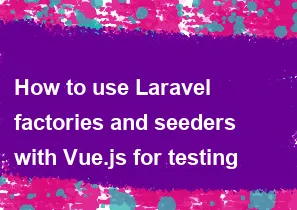How to use Laravel factories and seeders with Vue.js for testing

Laravel is a PHP framework that comes with built-in support for database seeding and model factories, which can be used to populate your database with test data. On the other hand, Vue.js is a JavaScript framework for building user interfaces, and it typically doesn't directly interact with databases like Laravel does.
If you want to use Laravel factories and seeders to populate your database with test data and then display that data using Vue.js, you can follow these general steps:
Create a Laravel Model:
- Create a Laravel Eloquent model for the data you want to seed and display.
bashphp artisan make:model PostCreate a Factory:
- Create a factory for the model using Artisan.
bashphp artisan make:factory PostFactory- Define the structure of the data you want to seed in the
PostFactoryclass.
php// database/factories/PostFactory.php use Faker\Generator as Faker; $factory->define(App\Models\Post::class, function (Faker $faker) { return [ 'title' => $faker->sentence, 'content' => $faker->paragraph, ]; });Create a Seeder:
- Create a seeder to use the factory and populate the database.
bashphp artisan make:seeder PostsTableSeeder- In the seeder, use the factory to create multiple records.
php// database/seeders/PostsTableSeeder.php use Illuminate\Database\Seeder; class PostsTableSeeder extends Seeder { public function run() { factory(App\Models\Post::class, 10)->create(); } }Run the Seeder:
- Run the seeder to populate the database with test data.
bashphp artisan db:seed --class=PostsTableSeederSet Up Vue.js Component:
- Create a Vue.js component that fetches data from your Laravel backend and displays it.
javascript// resources/js/components/PostList.vue <template> <div> <h2>Post List</h2> <ul> <li v-for="post in posts" :key="post.id"> {{ post.title }} </li> </ul> </div> </template> <script> export default { data() { return { posts: [], }; }, mounted() { this.fetchPosts(); }, methods: { async fetchPosts() { try { const response = await axios.get('/api/posts'); // Assuming you have a route for fetching posts this.posts = response.data; } catch (error) { console.error('Error fetching posts:', error); } }, }, }; </script>Create API Routes:
- Create API routes in Laravel to serve the data to your Vue.js component.
php// routes/api.php use App\Http\Controllers\PostController; Route::get('/posts', [PostController::class, 'index']);Create a Controller:
- Create a controller to handle the API requests.
bashphp artisan make:controller PostController- In the controller, define the
indexmethod to return the posts.
php// app/Http/Controllers/PostController.php use App\Models\Post; public function index() { return Post::all(); }Use the Vue Component:
- Include your Vue.js component in your Blade view or app.
html<!-- resources/views/welcome.blade.php --> <div id="app"> <post-list></post-list> </div> <script src="{{ mix('js/app.js') }}"></script>- Make sure your routes and components are registered correctly in your
app.jsfile.
Compile Assets:
- Compile your assets to make sure your Vue.js component is included.
bashnpm run devRun Laravel Development Server:
- Run the Laravel development server.
bashphp artisan serve
Now, when you access your application, it should display a list of posts fetched from the Laravel backend using Vue.js. This setup allows you to use Laravel factories and seeders to populate your database with test data, and then you can use Vue.js to fetch and display that data in your frontend.
-
Popular Post
- How to optimize for Google's About This Result feature for local businesses
- How to implement multi-language support in an Express.js application
- How to handle and optimize for changes in mobile search behavior
- How to handle CORS in a Node.js application
- How to use Vue.js with a UI framework (e.g., Vuetify, Element UI)
- How to configure Laravel Telescope for monitoring and profiling API requests
- How to create a command-line tool using the Commander.js library in Node.js
- How to implement code splitting in a React.js application
- How to use the AWS SDK for Node.js to interact with various AWS services
- How to use the Node.js Stream API for efficient data processing
- How to implement a cookie parser middleware in Node.js
- How to implement WebSockets for real-time communication in React
-
Latest Post
- How to implement a dynamic form with dynamic field styling based on user input in Next.js
- How to create a custom hook for handling user interactions with the browser's device motion in Next.js
- How to create a custom hook for handling user interactions with the browser's battery status in Next.js
- How to implement a dynamic form with dynamic field visibility based on user input in Next.js
- How to implement a dynamic form with real-time collaboration features in Next.js
- How to create a custom hook for handling user interactions with the browser's media devices in Next.js
- How to use the useSWRInfinite hook for paginating data with a custom loading indicator in Next.js
- How to create a custom hook for handling user interactions with the browser's network status in Next.js
- How to create a custom hook for handling user interactions with the browser's location in Next.js
- How to implement a dynamic form with multi-language support in Next.js
- How to create a custom hook for handling user interactions with the browser's ambient light sensor in Next.js
- How to use the useHover hook for creating interactive image zoom effects in Next.js